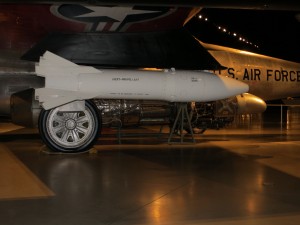
During the Cold War, Canada acquired aircraft capable of delivering nuclear weapons. In the midst of these complicated and expensive processes, the Diefenbaker government was elected in 1957, which re-examined the Canadian defence programme. Consequently, negotiations between the Canadian armed services and their American counterparts for access to the nuclear munitions necessary for these aircraft to fulfill their functions became entangled in political controversy. The Diefenbaker government, suspicious of anything that might compromise Canadian sovereignty and harbouring a small cadre of anti-nuclear members in its ranks, delayed dealing with the issue amid increased attacks by the political opposition, who initiated the strategic process in the first place when they were previously in government.
These deliberations took place against an increasingly Apocalyptic backdrop. The Soviet Union initiated an extremely dangerous crisis over access to West Berlin, a crisis which threatened to escalate into war. As that situation waned, another rapidly emerged in 1962 when the Soviet Union deployed intermediate and medium range ballistic missiles and tactical nuclear weapons to Cuba.
The Royal Canadian Air Force at this point had five squadrons of CF-101B Voodoo interceptors and two squadrons of BOMARC B heavy surface to air missiles from the RCAF’s Air Defence Command dedicated to protect North America as part of the North American Air Defence Command (NORAD) agreement.
Without a formal agreement between the two governments, access to nuclear warheads for these forces was problematic. During the course of events, however, provisions for the emergency deployment of nuclear weapons were explored by both countries. This took three forms: the first was what we would today call ‘just in time’ delivery of complete weapons from US bases as a crisis escalated; the second called for the delivery of a ‘missing essential part’ from US bases to be inserted once warning of an attack was given; and the third was the deployment of American aircraft to defend Canada. Up to now, the ability of the US Air Force to implement these options has been obscured by decades of secrecy. This study will examine the possibilities and their viability given availability of new information.